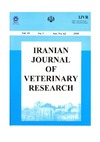Identificador persistente para citar o vincular este elemento:
https://accedacris.ulpgc.es/jspui/handle/10553/41459
| Título: | 3-D computed tomography reconstruction: Another tool to teach anatomy in the veterinary colleges | Autores/as: | Jáber Mohamad, José Raduán Carrascosa Iruzubieta, Conrado Javier Arencibia Espinosa, Alberto Corbera Sánchez, Juan Alberto Ramírez Corbera, Ana Sofía Melián Limiñana, Carlos |
Clasificación UNESCO: | 3109 Ciencias veterinarias 310901 Anatomía |
Fecha de publicación: | 2018 | Publicación seriada: | Iranian Journal of Veterinary Research | Resumen: | This letter underpins the use of three-dimensional computed tomography (3D-CT) reconstruction as an aid to teach veterinary anatomy. Cases were presented to students in order to observe normal and clinically abnormal patients. The images provided excellent details of relevant structures and could serve as a tool for teaching anatomy. Many sources describe different options to enhance anatomical learning by students through the use of modern imaging techniques such as computed tomography (CT) or magnetic resonance (MR) imaging. The contribution of CT to anatomical knowledge is limited due to the high cost and the lack of a suitable design for large animals, although recently studies have been reported on foals head (Cabrera et al., 2015). Advances in CT studies involve the generation of 3D-CT of the canine spine (Drees et al., 2009), the sea lion head (Dennison and Schwarz, 2008), or orbital diseases (Zafra et al., 2012). This study reports examples of this technique and its contribution to the understanding by the students. The CT images were obtained at the Veterinary Hospital of Las Palmas University from different cases. Transverse images were obtained using fourth generation CT equipment. Each patient was subjected to 3D reconstruction using a standard DICOM 3D format. The images were showed to a group of 20 students that had completed their basic training by learning anatomy through computer simulations. They could label relevant structures of the cervical spine of foal, including the atlas and its occipital articulation and the modified spinous process of axis (Fig. 1). In relation to the dog head, the 3D-CT showed the extent of the bony lesions, occupying the orbital region. It affected the maxillary border of the zygomatic and frontal bone (Fig. 2). In the last case, students visualized fractures of the dogskull. Additional transverse image showed contusional hemorrhage in the left parietal lobe and dilatation of lateral ventricles (Fig. 3). | URI: | https://accedacris.ulpgc.es/handle/10553/41459 | ISSN: | 1728-1997 | DOI: | 10.22099/ijvr.2018.4759 | Fuente: | Iranian Journal of Veterinary Research [ISSN 1728-1997], v. 19 (1), Number 62, p. 1-2 |
| Colección: | Artículos |
Citas SCOPUSTM
10
actualizado el 08-jun-2025
Citas de WEB OF SCIENCETM
Citations
7
actualizado el 25-feb-2024
Visitas
285
actualizado el 12-jul-2025
Descargas
105
actualizado el 12-jul-2025
Google ScholarTM
Verifica
Altmetric
Comparte
Exporta metadatos
Los elementos en ULPGC accedaCRIS están protegidos por derechos de autor con todos los derechos reservados, a menos que se indique lo contrario.
